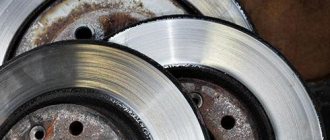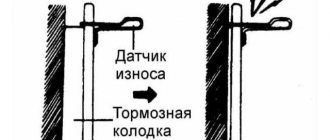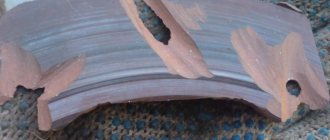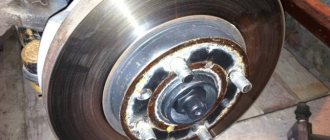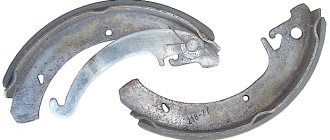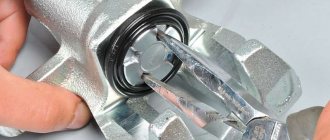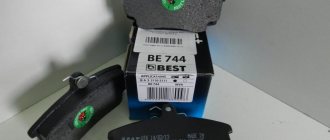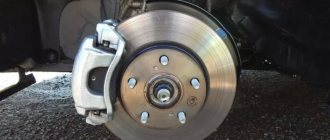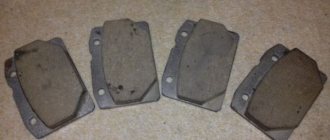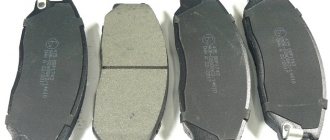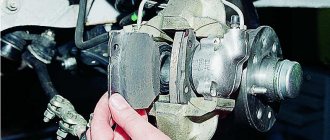The braking system is responsible for safe braking of the car. The efficiency and speed of stopping depends on its serviceability. The number of mechanisms in the brakes is quite large, and they all must work like clockwork, because the failure of one will entail at least unpleasant consequences. Let's talk about what the minimum thickness of brake pads should be, as well as ways to check for wear.
Symptoms of wear parts
While driving, there are several signs that you can use to determine when it’s time to change the pads of the front or rear brakes, or even all together. The symptoms are:
- a metallic grinding sound when you press the pedal indicates complete wear of the linings;
- increased travel of the brake pedal, its vibration when pressed;
- when braking, there is a feeling that the front or rear of the car is being pulled to the side, and on a slippery road the car easily goes into a skid;
- the handbrake does not work properly;
- To stop you need to put more force on the pedal.
If, when braking, a metallic grinding and squeaking sound is heard from the wheels, then the question of how long to change the unusable parts is no longer worth asking. Replacement must be done urgently, since there are no friction linings left and the steel base is rubbing against the working surface of the disk.
Never allow the brakes to wear out completely, otherwise you will have to replace the discs along with the pads, which is significantly more expensive.
If you notice one or more symptoms indicating problems with the wheel brake mechanisms, check the condition of the linings. Recommendations for performing diagnostics are as follows:
- If your car is equipped with alloy wheels with large holes, then you won’t have to disassemble anything to inspect the front calipers. If necessary, jack up the car to align the disc opening against the brake mechanism.
- Wheels with steel rims must be removed. Inspect the front brake pads and evaluate the thickness of the linings. If it is less than 3 mm, the parts should be replaced immediately. With a thickness of 3-5 mm you can drive another 1-2 thousand km, no more.
- Rear brakes are disc or drum. The first ones are examined similarly to the front ones, but the second ones will have to be disassembled. Remove the wheel and release the handbrake, then unscrew the drum and carefully knock it off the hub. Unlike the front pads, the rear pads need to be changed when the thickness is 1.5-2 mm.
We recommend: How to install a deflector (fly swatter) on the hood: step-by-step photo instructions
When, as a result of diagnostics, wear of elements close to the maximum is detected, but replacement is postponed for various reasons, drive carefully and without haste. It happens that a worn lining comes off completely when you press the pedal sharply .
When conducting diagnostics, pay attention to the working surface of the brake drums and discs. If its wear is 2 mm or more (determined by the depth of the groove with a caliper), then the part must be replaced.
What conclusions can be drawn?
So we figured out how to determine brake pad wear. This can be done visually, or using a ruler or caliper. If you do not have the time and desire to deal with this issue yourself, then entrust this matter to the specialists at the service station.
The minimum thickness of brake pads should be 2-4 mm, but values such as 1.5 mm are allowed. If the overlay is smaller, we change it. If it is within the acceptable range, but is already suitable, we are preparing to replace it soon. It is also worth regularly checking the brake discs for wear and overheating. The latter leads to the disc warping, and the system works less efficiently - the braking distance increases and runout appears. So we figured out when the brake pads are replaced. The price for them differs depending on the manufacturer and varies between 800-3500 rubles. But you don’t need to take the cheapest “musical” friction linings.
During breaks between scheduled maintenance, the car owner must monitor the condition of the brake system. Anyone can assess the wear of brake pads and discs (drums), the main thing is not to be lazy.
LADA > Kalina
In most cars, during normal use, the inner pad wears out a little faster than the outer one, and this does not depend on the design of the brake mechanisms. However, under specific operating conditions or due to the design features of some machines, the internal pads sometimes wear out noticeably more intensively than the external ones. For example, on a second-generation Mazda 6, the inner pad on the front right wheel wears out one and a half times faster than the outer one.
In addition to design nuances, malfunctions may also occur. For example, increased pad wear due to a soured piston. Therefore, when inspecting the brakes for the first time on a car you have never driven before, it is important to remove the wheel to assess the condition of both the outer and inner pads. Unscrupulous servicemen often limit themselves to an approximate assessment of the wear of only the outer pads, examining them through the spokes of the wheel rim, without removing the wheel itself. It is possible that soon a dissatisfied customer will return to this service station with worn out internal pads and complaints!
As an example, let's check the condition of the brakes on the editorial Kalina, which has driven almost 63,000 km. In addition, we provide approximate indicators for critical wear of various elements of the brake system. For each specific car model, they may differ either up or down. This data can be found in repair and maintenance books or on the Internet.
But let's return to our Kalina. Only after removing the wheel is the real picture visible. The thickness of the friction lining is approximately equal to the thickness of the pad base: wear is about 60%. If the thickness of the friction lining decreases to 2 mm, this will mean 100% wear. Many cars have a metal tongue at the base of the block. When the lining wears critically, it begins to come into contact with the brake disc, producing a characteristic squeak. Most often, the tongue is installed only on the inner pads.
Important information about brake disc thickness
In the past, most brake rotors were designed to be thick enough that there was little need for replacement. Nowadays, in order to reduce weight and save some costs, many automakers often produce wheels with a thinner thickness. Thus, the rotors easily wear down to the minimum thickness (the appropriate tolerances are usually specified in the factory instruction manual or on the rotor casting), sometimes even by the time the first set of brake pads are replaced.
Example: minimum thickness of JCW rear brake disc is 8.4 mm
Knowing the minimum thickness of your car's rim is very important because if the thickness of the car's rotor is less than the minimum level, your safety will be compromised. A worn or thinner rotor has less mass than a normal rotor, which reduces its ability to absorb and dissipate heat. In addition, the strength of the rotor is also reduced, leading to a greater risk of cracking and braking. For this reason, it is very important to check the rotor thickness every time you service your brake pads. If the rotor thickness is below the minimum specification or cannot be repaired, you must replace it immediately.
Cracked brake disc
The front discs on a car are subject to more wear than the rear ones. But at the same time, both front discs usually wear out equally (as do the rear ones). Therefore, when it comes to replacing one worn rotor, this means that you must replace both rotors on the vehicle.
Auto experts advise replacing both rotors (even if one is still functional) at the same time to maintain even braking. A noticeable difference in rotor thickness can cause the brakes to be biased to one side.
About the main types of pads
The automotive industry has come a long way in recent years. A modern car, as a rule, has an advanced braking system; this is the presence of computer-controlled systems. This should include ABS, directional stability system, etc. The constant development of cars leads to progress in the types of brake pads. The following types are distinguished:
- with a semi-metallic friction layer (65% copper, iron powder, wire);
- organic friction layer (rubber, glass, Kevlar);
- from organics and metallic inclusions in a ratio of 70/30);
- ceramic friction layer with a small inclusion of copper.
Each of the above types has its own strengths and weaknesses. For example, a semi-metallic friction layer has good heat dissipation, but it wears out quickly and makes a lot of noise during operation. But organic brake pads make virtually no noise and operate smoothly, but in the process they emit a lot of dust that settles on the wheel disc. We can safely say that ceramic ones are the most preferable. They do not make noise and do not wear out too quickly. Their only drawback is their high cost.
What factors influence wear?
The wear of brake system components depends on many factors:
- poor quality material used by the manufacturer;
- installation of any element: pad, disc or drum was previously carried out incorrectly;
- aggressive driving style of the car owner.
We recommend: Gasoline or diesel. What's better?
The reasons listed apply to all parts of the brake system. We’ll tell you how you can avoid such factors and significantly increase their service life.
Important! It is necessary to purchase parts from trusted manufacturers.
There are plenty of counterfeit goods on the market. The cheap cost of the product should indicate to the car enthusiast that the spare part can be made from low-grade raw materials. In this case, you won’t be able to save money: its service life may quickly end.
Important! Replacement of all brake elements must be carried out by qualified specialists at a service station.
Their experience and modern repair equipment are the guarantee of installation. Repairs in a nearby garage or in “left” services are dangerous due to incorrect installation and repair costs, the purchase of new spare parts, and the creation of an emergency situation.
Important! Driving should be calm, without alternating sharp accelerations, sports starts at traffic lights and extreme braking.
The listed actions lead to an increase in the temperature regime for parts and the creation of prohibitive loads. The result is their wear and failure.
What is this detail?
The brake pad is a steel plate with a lining made of materials that can withstand high friction. She constantly works in unfavorable conditions. In addition to the aforementioned friction and subsequent heating, it is affected by water (which leads to a sharp temperature change) and other factors, for example, road reagents. Over time, cracks appear on the surface of the linings, their thickness decreases, and the car begins to brake worse.
What should be the thickness of brake pads?
A clear sign indicating that the pads are running out of service life is the appearance of a characteristic whistle when the car is braking - every time you press the pedal you will hear an unpleasant noise, similar to glass rubbing against metal.
If such a symptom appears, it is recommended to diagnose the brake system as soon as possible - remember, operating a car with faulty brakes negatively affects the safety of the driver and passengers.
| Characteristic | Wheel Bridge | Minimum thickness, mm |
| Disc diameter, mm | Front | 256 |
| Rear | 238 | |
| Structure thickness, mm | Front | 12 |
| Rear | 12 | |
| Possible runout, mm | Front | 0,07 |
| Rear | 0,07 | |
| Thickness of the brake lining together with the pad body, mm | Front | 18 |
| Rear | 18 | |
| Minimum permissible thickness of the lining together with the block body, mm | Front | 6 |
| Rear | 6 | |
| Minimum permissible disk thickness, mm | Front | 10.6 |
| Rear | 10.6 |
It is also important to remember that these indicators may differ if the car has a power unit with a capacity of more than 125 horsepower or a total volume of working chambers of 2.0 liters or more. In this case, it is necessary to check the thickness level of the system components after first reading the data from the vehicle’s service book.
Note! On average, front and rear brake pads, regardless of the design of the system, wear out at different rates. This is explained by the difference in the applied dynamic force on the braking system - the front axle of the car experiences more pressure during a forced reduction in speed.
How to determine pad wear at home
For self-diagnosis, you will need no more than 15 minutes, as well as the presence of a jack, a wheel wrench, and a ruler or caliper.
The entire procedure is performed as follows:
- We lift the required part of the car using a jack, and then remove the wheel to provide access to the brake mechanism;
- Next, use a measuring tool to check the thickness of the bracket in the special window on the brake mechanism. If the thickness of the brake linings does not meet the acceptable level, the parts will have to be replaced;
- Then, using the same method, we measure the thickness of the brake disc - if the indicator is insufficient, the part must also be replaced.
The thickness of the rear axle brake system is measured along with the base on which the friction lining is mounted. To provide access to the parts, in addition to the wheel, you will also have to dismantle the drum mechanism. Also at this stage, it would be reasonable to check the diameter of the working surface of the drum - if it is larger than permissible, it is also recommended to replace the structure.
Note! It is recommended to replace the brakes comprehensively, that is, in pairs on the wheel axle - otherwise there is a possibility of uneven operation of the braking system, which will lead to destabilization of the vehicle on the road during a decrease in speed.
Also, after servicing, it is recommended to undergo a short run-in within 100-150 km so that the friction layer of the components gets used.
Limit value of residual thickness
Obviously, the intensity and duration of the impact of the listed circumstances on the service life of the braking system differs for each specific car - one driver drives carefully, another constantly loads the car, a third uses only high-quality original spare parts.
We recommend: Design and principle of operation of a modern torque converter
From a technical point of view, it is incorrect to say that it is time to replace the brake pads if a certain period of time has passed (for example, 1 year) or a certain mileage has been reached. The mileage resource, expressed in km, is an average value and can be used for guidance only.
The following values are usually given: for disc brakes installed on both front and rear axles, it is 10–20 thousand km; for drum wheels, used mainly on the rear wheels – 100–150 thousand km.
In reality, the need for replacement occurs only when the maximum remaining thickness of the lining is reached. The manufacturer usually indicates this value on the product packaging, and the manufacturer - in the maintenance and repair manual. For most modern passenger cars, it fluctuates in the range of 1–2 mm for the brake mechanisms of both front and rear wheels.
Why do pads wear out too quickly?
There are several obvious reasons for premature lining wear. Constant driving around the city, when you have to brake often. This leads not only to wear, but also to high temperature of the disc and pads. Many motorists prefer aggressive driving with prolonged and sharp braking. This also results in high wear rates. While a quiet ride often contributes to a long “life” of the brakes.
If you often have to drive with a loaded trunk, then this, on the contrary, helps reduce the load on the front axle and brakes, respectively. In general, it is recommended to change brake pad linings within the time limits specified by the manufacturer. For the rear axle this is usually 40,000 km, and for the front axle approximately 20,000 km. Although they can fail either earlier or later, it is better to carry out regular checks.
Other reasons for replacing pads
In addition to situations with critical wear, it is necessary to change brake pads in the following cases:
- the thickness of the friction material is more than 5 mm, but the lining itself has begun to peel off from the steel base;
- cracks and chips appeared on the surface, the material began to crumble;
- stains of oil or brake fluid that reduce friction properties were found on the parts;
- when the brake drum or disc is replaced.
Another reason for replacement is due to the abundance of low-quality fakes on the automotive spare parts market . New pads purchased from an unreliable retail outlet begin to squeak or squeak terribly after 1-2 thousand km, although the working part is still far from completely worn out. The culprit is the material of the part, whose hardness is comparable to metal, causing the surface to “slick” and create a creaking sound. If the elements made from unknown materials are not replaced, then the production on the brake discs will increase sharply.
Many modern cars are equipped with special sensors that detect a decrease in the thickness of the friction layer and send a signal to the driver when it reaches a critical level. This is also a reason to remove parts with worn linings and install new ones.
True, the sensors often become clogged with dirt and lose their functionality, so it wouldn’t hurt for the car owner to check the condition of the brakes himself.
About what not to do
Not every car owner regularly checks their brake system. This leads to a variety of consequences, including accidents on the road. This is still good if you crash into a tree in your yard, but what if the brakes fail on the highway? Of course, experienced motorists will use engine braking, but not everyone will have time to figure out what’s going on.
So, never allow the brake pad linings to wear down to metal. This will damage the brake disc and ultimately cause the system to fail. Check the condition of the brakes regularly. It’s not difficult to do this yourself. You shouldn’t crawl under the car every 5 thousand km, but when the time comes, don’t be lazy.
When to check brake disc thickness
A rotor thickness check should be done whenever you replace brake pads. This will ensure there is enough metal on the rotors to brake safely. It is recommended to do this every time you change your brake pads, regardless of the interval between changes. The verification process will take you less than 5 minutes and will be a good security measure.
To check the thickness of the brake disc, you only need any caliper
Indirect signs of wear
The condition of the pads and discs should be assessed at the first non-standard manifestations:
- long braking distance on dry road conditions;
- noise, metallic grinding noise that occurs when braking;
- The trajectory of the car when braking is unpredictable. He drives the car and skids.
The driver is responsible for the condition of his vehicle. If abnormalities are detected in the braking system, it is prohibited to continue driving. To avoid a complete stop, it is better to identify a potential malfunction in advance. If there are signs of problems with the brakes, you should contact a service station that has a specialized stand. Such a check will remove all doubts.
The brake system is an important and critical element in any car. This unit is highly reliable. But this is only possible if consumables are regularly replaced. How are brake pads and brake discs replaced? In today's article you will find out the answer to this question.
Changing disks
To do this, we need to fix the car on the handbrake or gear and hang the desired side (similar to the previous instructions). Press out the piston of the working cylinder. Then we remove all the dirt deposits from the hub and the caliper itself. After this, ask the assistant to press the brake all the way. At this time, you need to remove the bolts securing the disc to the hub. If the threads are soured, use Liquid Key lubricant. Next, remove the brake caliper. The latter is fixed on the wire so that the rubber hose is not damaged.
So, we found out how to replace rear brake pads and discs with your own hands.
The brake disc in the design of the car chassis is designed to stop the rotation of the wheel due to friction forces that arise when the working surfaces of the disc come into contact with the friction material of the brake pads. Frictional energy is converted into heat, which is then dissipated into the surrounding air.
The front brake discs take the main load when braking. They are made reinforced - they have a larger thickness and diameter compared to the rear ones. To improve heat dissipation efficiency, the front brake discs are additionally equipped with ventilation channels or holes. This type of part, along with the pads, is a consumable item and changes as it reaches critical wear.
Diagnosis of the cause by wear
Most often, the pads wear out differently on all wheels in a car. Moreover, the front axle is loaded more heavily during braking, since the body tilts forward due to inertia, and the rear axle is unloaded. If the driver uses hard braking, the linings will wear out much faster.
Many modern models are equipped with an ESP system (how the exchange rate stabilization system works is described separately ). The peculiarity of this device is that it automatically brakes when there is a risk of the car skidding. Although such a system provides safety and control of the vehicle, its frequent operation causes wear on individual pads, and this process cannot be controlled. Otherwise, you have to turn off the device (how this is done is described here ).
Here is a short list of the reasons why frequent or unnatural pad wear occurs.
Wedge wear
The reasons for this effect may be:
- Errors when installing pads;
- The material of the block linings is of poor quality;
- A feature of the design of some brake systems, for example, those that are equipped with additional calipers to improve performance;
- The caliper bracket must effectively guide the part so that all parts of it are simultaneously adjacent to the disc. This may not occur due to poor tightening of the mounting bolt;
- Violation of the rules for tightening the fastening bolt of the bracket can lead to its deformation;
- Malfunctions in the chassis of the car, for example, wear in the wheel bearing, which causes play (this happens extremely rarely);
- Souring of guides;
- The bearing on the struts (or strut) has a bent axle.
Rapid pad wear
Accelerated production of material may be due to the following reasons:
- The pad has the wrong material for the specific vehicle, such as being too soft;
- Aggressive driving;
- The car is equipped with an ESP system;
- Development on the brake disc or drum;
- Incorrect caliper adjustment - the pad is pressed against the surface of the disc or drum;
- The car sits idle for a long time.
